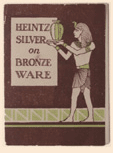|
|
 |
|
|
 |
 |
FREQUENTLY ASKED
QUESTIONS |
| |
|
| |
|
| |
|
| |
Q:
Which is correct: Heintz Art Metal, Heintz
Metal Art or Heintz Art?
A: Items
made by the Heintz Art Metal Shop are
properly called Heintz Art Metal.
Unfortunately the term “art metal” has not
gained the same popular acceptance and use
as its ceramic cousin, “art pottery”. The
terms are analagous. |
 |
| |
 |
| |
|
Q:
Any relationship to the Heinz Co. of
Pittsburgh? Did they make metal items also?
A: Only
the cans that the pickles or beans came in. |
|
| |
 |
| |
|
Q:
I have four Heintz vases, all dated August
27, 1912. That’s really some coincidence,
isn’t it?
A: Hardly!
The die-stamped legend on the bottom of your
vases, PAT.AUG.27.12, does NOT refer to a
date of manufacture. It is the date of
issuance of the patent for the application
of sterling silver overlays to bronze
without the use of solder. Your vases were
presumably manufactured after that date and
before Heintz closed its doors in February,
1930. |
|
| |
|
 |
|
| |
 |
| |
|
Q:
My bowl doesn’t have the diamond mark but I
have seen the same form with the mark.
How do I know that mine is a Heintz bowl?
A:
Look closely. The words PAT APD FOR were
die-stamped on the bottom of items
presumably made between June 7, 1911 , the
date the PATent was APplieD FOR, and August
27, 1912 , the date it was granted. Prior to
June 7, the word STERLING was often
die-stamped into a corner of the overlay. In
both cases, a 4-digit production number was
sometimes also used. For a bowl, the first
two digits would be 35, 36, 37, or 38. If
the bowl was footed, had handles, or was
lined (double-weight), the first two numbers
would be 17 or 18. |
|
| |
 |
| |
|
Q:
It says BRONZE on the bottom, so why isn't
it heavy?? Why is it copper-colored?
A: THE
THINKER by Rodin is cast bronze and solid,
the vase by Heintz is spun bronze and is
sheet metal. The bronze, normally
yellow-colored before patination, is
copper-plated if it is to be patinated a
brown color. If it is to be Heintz's green
finish, it doesn't get plated and remains
yellow-colored. Your piece was once brown,
and has had its original finish
over-zealously scrubbed off. |
|
| |
 |
| |
|
Q:
Are green patina pieces worth more than
their brown counterparts?
A: 1916
catalog brochure states on each page "Brown
patina will be furnished unless otherwise
specified". This probably explains the
imbalance between the number of pieces in
each finish we see today. I believe
collectors have personal preferences and
purchase accordingly. |
|
| |
 |
| |
|
Q:
The patina will return over time, right?
A:
SOMETHING will happen with the passage of
time, but it will bear no resemblance to the
original factory finish. . The Heintz
patinas, like those of other Arts & Crafts
period metalworks, were factory-applied
finishes produced with chemicals and heat. |
|
| |
 |
| |
|
Q:
How DO
you clean the silver?
A: You
don’t!! I quote from the little booklet
included with each new purchase: “Each piece
of Heintz ware is lacquered with the highest
grade lacquer obtainable, and will not
tarnish. To keep this ware clean, merely
wipe with dry soft cloth.” |
|
 |
|
| |
 |
| |
|
Q:
My vase says RH Macy & Co. underneath the
diamond mark. Is it worth more?
A: Only
if you are a Macy’s memorabilia collector.
Macy’s was significant enough of a retailer
to merit its own die-stamp. Others seen are
Ovington, B.Altman & Co., and Cross. |
|
| |
 |
| |
|
Q:
What is the relationship between Heintz Art
Metal Shop and Silver Crest?
A:
SILVERCREST is the mark of the Smith Metal
Arts Co. Fred Smith was Heintz’s sales
manager, and left in April 1919 to compete
with his ex-employer. He initially used many
of the same forms and overlays but didn’t
replicate the patinas. |
|
| |
 |
|
| |
|
 |
MAKER'S MARKS |
| |
|
| |
|
| |
|
 |
PRODUCTION NUMBERS |
| |
|
| |
|
400-600s |
Ash bowls, card plates and trays |
|
1000-1200s |
Desk sets and desk accessories |
|
1700-1800s |
Footed, two-handled and double weight
(lined) bowls |
|
2000-2100s |
Picture frames |
|
2400s |
Smoker's items made by stamping (ie: square
or angular) |
|
2500-2600s |
Smoker's items made by spinning (ie:round) |
|
3000-3100s |
Candlesticks |
|
3500-3800s |
Vases and single-weight bowls |
|
4000-4100s |
Smokers boxes and humidors (usually
cedar-lined) |
|
4700- 4800s |
Table match boxes (matchsafes) |
|
4900s |
Pocket match cases (matchbook cases) |
|
5500s |
Lamps |
|
6500-6600s |
Trophies, loving cups and plaques |
|
7000-7200s |
Bookends |
|
7500s |
Bookmarks |
|
7700s |
Paper knives (letter openers) |
|
| |
|
|
|
|
|
|
|
